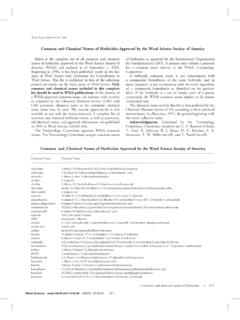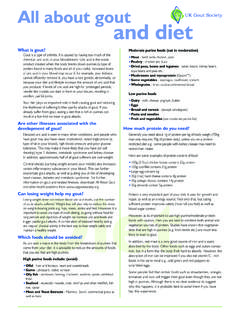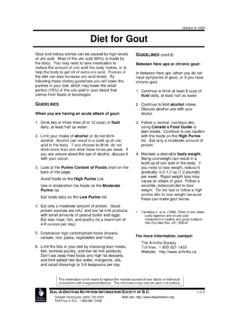Transcription of Summary of Herbicide Mechanism of Action According to …
1 Summary of Herbicide Mechanism of Action According to the Herbicide Resistance Action Committee (HRAC) and Weed Science Society of America (WSSA) Classification . A(1). Acetyl CoA Carboxylase (ACCase) Inhibitors Aryloxyphenoxypropionate (FOPs) and cyclohexanedione (DIMs) herbicides inhibit the enzyme acetyl- CoA carboxylase (ACCase), the enzyme catalyzing the first committed step in de novo fatty acid synthesis (Burton 1989; Focke and Lichtenthaler 1987). Inhibition of fatty acid synthesis presumably blocks the production of phospholipids used in building new membranes required for cell growth. Broadleaf species are naturally resistant to cyclohexanedione and aryloxyphenoxy propionate herbicides because of an insensitive ACCase enzyme. Similarly, natural tolerance of some grasses appears to be due to a less sensitive ACCase (Stoltenberg 1989).
2 An alternative Mechanism of Action has been proposed involving destruction of the electrochemical potential of the cell membrane, but the contribution of this hypothesis remains in question. B(2) Acetolactate Synthase (ALS) or Acetohydroxy Acid Synthase (AHAS) Inhibitors Imidazolinones, pyrimidinylthiobenzoates, sulfonylaminocarbonyltriazolinones, sulfonylureas, and triazolopyrimidines are herbicides that inhibit acetolactate synthase (ALS), also called acetohydroxyacid synthase (AHAS), a key enzyme in the biosynthesis of the branched-chain amino acids isoleucine, leucine, and valine (LaRossa and Schloss 1984). Plant death results from events occurring in response to ALS inhibition and low branched-chain amino acid production, but the actual sequence of phytotoxic processes is unclear. C1(5) C2(7) C3(6).
3 Photosystem II Inhibitors Phenylcarbamates, pyridazinones, triazines, triazinones, uracils (Group C1 (5)), amides, ureas (C2 (7)), benzothiadiazinones, nitriles, and phenylpyridazines (Group C3 (6)), are examples of herbicides that inhibit photosynthesis by binding to the QB-binding niche on the D1 protein of the photosystem II complex in chloroplast thylakoid membranes. Herbicide binding at this protein location blocks electron transport from QA to QB and stops CO2 fixation and production of ATP and NADPH2 which are all needed for plant growth. However, plant death occurs by other processes in most cases. Inability to reoxidize QA promotes the formation of triplet state chlorophyll which interacts with ground state oxygen to form singlet oxygen. Both triplet chlorophyll and singlet oxygen can abstract hydrogen from unsaturated lipids, producing a lipid radical and initiating a chain reaction of lipid peroxidation.
4 Lipids and proteins are attacked and oxidized, resulting in loss of chlorophyll and carotenoids and in leaky membranes which allow cells and cell organelles to dry and disintegrate rapidly. some compounds in this group may also inhibit carotenoid biosynthesis (fluometuron) or synthesis of anthocyanin, RNA, and proteins (propanil), as well as effects on the plasmalemma (propanil) (Devine et al. 1993).. The capitalized letter in the colored boxes represents the Herbicide Resistance Action Committee (HRAC) classification and the number superscripted in parentheses represents the Weed Science Society of America classification. 11. Summary of Herbicide Mechanism of Action According to HRAC and WSSA Classification D(22). Photosystem I Inhibitors Bipyridyliums are examples of herbicides that accept electrons from photosystem I and are reduced to form an Herbicide radical.
5 This radical then reduces molecular oxygen to form superoxide radicals. Superoxide radicals then react with themselves in the presence of superoxide dismutase to form hydrogen peroxides. Hydrogen peroxides and superoxides react to generate hydroxyl radicals. Superoxides and, to a lesser extent, hydrogen peroxides may oxidize SH (sulfhydryl) groups on various organic compounds within the cell. Hydroxyl radical, however, is extremely reactive and readily destroys unsaturated lipids, including membrane fatty acids and chlorophyll. Hydroxyl radicals produce lipid radicals which react with oxygen to form lipid hydroperoxides plus another lipid radical to initiate a self-perpetuating chain reaction of lipid oxidation. Such lipid hydroperoxides destroy the integrity of cell membranes allowing cytoplasm to leak into intercellular spaces which leads to rapid leaf wilting and desiccation.
6 These compounds can be reduced/oxidized repeatedly (Dodge 1982). E(14). Protoporphyrinogen Oxidase (PPG oxidase or Protox) Inhibitors Diphenylethers, N-phenylphthalimides, oxadiazoles, oxazolidinediones, phenylpyrazoles, pyrimidindiones, thiadiazoles, and triazolinones are herbicides that appear to inhibit protoporphyrinogen oxidase (PPG oxidase or Protox), an enzyme of chlorophyll and heme biosynthesis catalyzing the oxidation of protoporphyrinogen IX. (PPGIX) to protoporphyrin IX (PPIX). Protox inhibition leads to accumulation of PPIX, the first light-absorbing chlorophyll precursor. PPGIX accumulation apparently is transitory as it overflows its normal environment in the thylakoid membrane and oxidizes to PPIX. PPIX formed outside its native environment probably is separated from Mg chelatase and other pathway enzymes that normally prevent accumulation of PPIX.
7 Light absorption by PPIX apparently produces triplet state PPIX which interacts with ground state oxygen to form singlet oxygen. Both triplet PPIX and singlet oxygen can abstract hydrogen from unsaturated lipids, producing a lipid radical and initiating a chain reaction of lipid peroxidation. Lipids and proteins are attacked and oxidized, resulting in loss of chlorophyll and carotenoids and in leaky membranes which allows cells and cell organelles to dry and disintegrate rapidly (Duke 1991). F1(12) F2(28) F3(11). Carotenoid Biosynthesis Inhibitors Amides, anilidex, furanones, phenoxybutan-amides, pyridiazinones, and pyridines (F1(12)) are examples of compunds that block carotenoid biosynthesis by inhibition of phytoene desaturase (Bartels and Watson 1978;. Sandmann and B ger 1989). Carotenoids play an important role in dissipating the oxidative energy of singlet O2 (1O2).
8 In normal photosynthetic electron transport, a low level of photosystem II reaction center chlorophylls in the first excited singlet state transform into the excited triplet state (3 Chl). This energized 3 Chl can interact with ground state molecular oxygen (O2)to form 1O2. In healthy plants, the energy of 1O2 is safely quenched by carotenoids and other protective molecules. Carotenoids are largely absent in fluridone-treated plants, allowing 1O2 and 3 Chl to abstract a hydrogen from an unsaturated lipid ( membrane fatty acid, chlorophyll). producing a lipid radical. The lipid radical interacts with O2 yielding a peroxidized lipid and another lipid radical. Thus, a self-sustaining chain reaction of lipid peroxi dation is initiated which functionally destroys chlorophyll and membrane lipids. Proteins also are destroyed by 1O2.
9 Destruction of integral membrane components leads to leaky membranes and rapid tissue desiccation. 12. Summary of Herbicide Mechanism of Action According to HRAC and WSSA Classification Callistemones, isoxazoles, pyrazoles, and triketones (F2(28)) are examples of herbicides that inhibit p- hydroxyphenyl pyruvate dioxygenase (HPPD), which converts p-hydroxymethyl pyruvate to homogentisate. This is a key step in plastoquinone biosynthesis and its inhibition gives rise to bleaching symptoms on new growth. These symptoms result from an indirect inhibition of carotenoid synthesis due to the involvement of plastoquinone as a cofactor of phytoene desaturase. Recent evidence suggests that clomazone (F3(11)) is metabolized to the 5-keto form of clomazone which is herbicidally active. The 5-keto form inhibits 1-deoxy-D-xyulose 5-phosphate synthase (DOXP), a key component to plastid isoprenoid synthesis.
10 Clomazone does not inhibit geranylgeranyl pyrophosphate biosynthesis (Croteau 1992; Weimer 1992). Amitrole (F3(11)) inhibits accumulation of chlorophyll and carotenoids in the light (Ashtakala, 1989), although the specific site of Action has not been determined. Precursors of carotenoid synthesis, including phytoene, phytofluene, carotenes, and lycopene accumulate in amitrole-treated plants (Barry and Pallett 1990), suggesting that phytoene desaturase, lycopene cyclase, imidazoleglycerol phosphate dehydratase, nitrate reductase, or catalase may be inhibited. Other research (Heim and Larrinua 1989), however, indicates that the histidine, carotenoid, and chlorophyll biosynthetic pathways probably are not the primary sites of amitrole Action . Instead, amitrole may have a greater effect on cell division and elongation than on pigment biosynthesis.







